
"In Beautiful
Brighton, Ontario"

The Beginnings of Presqu'ile Provincial Park
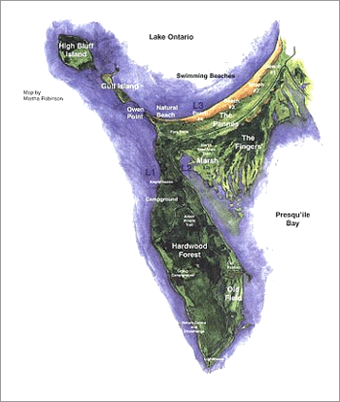
First Commission
Presqu'ile Peninsula has always been considered government owned, and up to November of 1920 it was controlled by the Dominion Government. In November of 1920 Presqu'ile came under the jurisdiction of the Militia Department. In 1921 the Dominion Government transferred the jurisdiction, except the reserve of 120 acres around the lighthouse, to the Provincial Government.
On May 22, 1922 the first five-man Commission, made up appointed local people, were granted powers similar to a municipal council. This commission was made up of two Conservatives and three Liberals. On the first board were R.B. Scripture, Robert Wade, J.F. Langdon, E.H. Bates, and Brighton barrister George Grewry.
This group was to be in charge of all aspects of running the Park. They hired a superintendent from the community, leased out the land, passed and enforced by-laws governing the area and saw that the taxes were collected. The funds were used to hire help and see that the Park had all the essential facilities. Roads were built, wells were installed, outhouses were looked after, garbage collected, trees were planted and the Park was beautified.
Coal was very scarce in the winter of 1922. Seven men went over to the park and cut out the big trees that needed to come down. They started this winter works project over on Half Bluff. The large maples and oaks were taken down, loaded on sleighs and taken to a selected wooded area, near the boardwalk today. Harren Tackaberry had his drag saw (a saw that was run by power but looked like a hand saw) set up and these logs were then cut into blocks. The blocks were then loaded on to sleighs and taken over to Brighton. A full cord delivered to your house at this time cost about $ 3.50.
After they had cleared out the marked trees, they moved over to a little house on the farm of Wilfred Craig. This house was located near where they group camping area is today. About four teams were hired and they worked six days a week. Over 100 loads of woods were cut from the Jobes’ woods that winter.
Darwin Simpson, along with his men and teams, took about two months to build the entire road. Jim Simpson, at 15 years of age, was in charge of keeping the books for his father, as well as helping with the construction of the road bed. This first appointed commission was credited for building the first road, on the south shore of the Park, in the spring of 1923.
Second & Third Commission
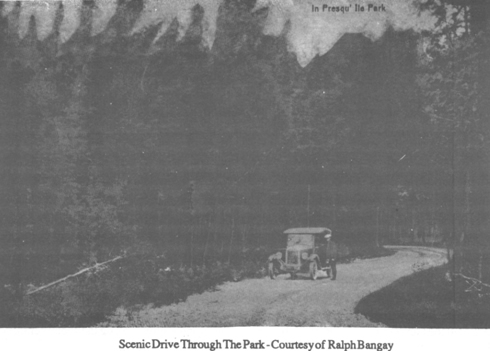
The second Commission was under a Conservative Government from 1923 to 1934. Mr.Oaks was then the superintendent.
The third Commission from 1934 to 1943 appointed Jim Simpson superintendent. As superintendent, Jim was policeman, game warden, garbage collector, tax assessor, and supervisor of all the work that was done in the Park during these years. Jim had one helper from spring to fall who received 25 cents per hour. Jim received 35 cents per hour and, if he used his own team on the job, he would make 50 cents for both team and driver.
The revenue for operating the Park came from the cottage leases and taxes. Most of these cottages were east of the hotel and were leased on annual basis. The people paid an average of $10 to $15 for a year’s lease and about $10 to $25 for taxes on the buildings. The mill rate remained at 12 mill for the entire third Commission. A few people owned their lots and they were generally assessed at a $1 a foot. If they built on it, then the building was also assessed. Grant Quick paid the most taxes at $252 per year.
The cottages received garbage pickup twice a week and, in the winter. Mr. Simpson would go over to the Park and park at the Hotel. He then would walk along the shoreline and swing up along the road inspecting the cottages to see that all was safe and sound. Times were tough in the 1930’s and this security patrol of the cottages was an extra precaution. Twice a week, Jim went over and did his walk. He remembers getting $4.50 per week for this effort.
The public had free use of the Park. There were some picnic tables available, and there were wooden out-houses. During the summer months there would often be up to 1,000 people enjoying the fine sand beach on a Sunday. Cars were allowed to drive on the beach at this time and one person was able to supervise the area. If someone wanted to camp for a few days, he just picked out a spot and set up a tent. Social activities were always left in the hands of private individuals, with the Hotel and Pavilion being the social centre of the entire area during the summer.
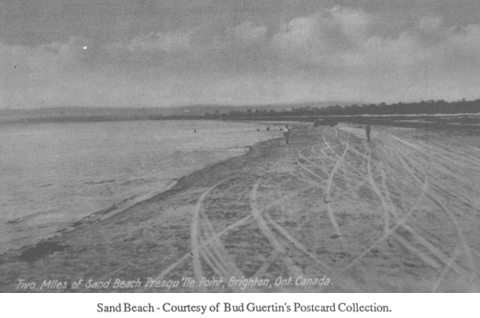
Every spring evergreens would be planted. During the third Commission 10,000 trees were planted each spring. These trees would come from Orono. The Commission had to pay the freight charges and pay for help to plant them. Mr. Simpson would go to the train station and pick up the trees and the yearly tree planting would start. It would take six men about two weeks. The men were put into teams of two to set out the trees.
Once the grass was burned, trees planted and roads graded, it was time to get the facilities ready for summer visitors. All the outhouses had to be cleaned and fresh lime put in them. This job was always scheduled in the spring and then four to five times during the summer.
There were five wells located throughout the Park then. Most of them were 85 feet deep and put in by a man named Hillier from the village of Hillier. Each spring the wells had to be pumped out and chloride put in them. These wells were located where the park store is today, at the old schoolhouse, east of Stonehedge, and the last two east of the Hotel.
One year there was a fire, and a bucket brigade was formed. It is believed that one well was pumpted dry during the fire, because the water tasted of sulphur. Although another well was drilled by the Commission some 100 feet away, the new well was no better.
In the 1950’s the members of the Commission were: E.J. Nesbitt, Vice Chair V. Chapman, Secretary Lome Lockwood, R.J. Ross, L.B. Solomon, commission clerks. The meetings were held the 4th Tuesday in the evening. The commission office was over the Maybee’s store in Brighton.
Presqu'ile Park - The Early Years
In the 1930’s Presqu’ile Park was stocked with deer. Gradually the number of people using the Park multiplied and the cars driving on the beach became a real worry both to the deer and to parents with young children. The Commission had Jack Atkins, the superintendent at this time, charging 25 cents for each car that went on the beach. This was done in hopes that teens cruising would be deterred and traffic problems would improve. New problems were cropping up each year. Eventually the Commission wrote to Queens Park that it was becoming too much for the local people to handle.
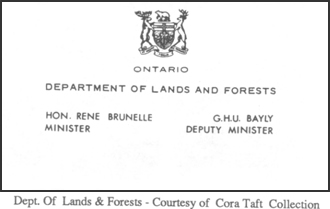
In 1955, the Park Commission was dissolved. The Commission handed over the control of Presqu’ile to a division of the Department of Lands and Forests, now the Ministry of Natural Resources. Presqu’ile became part of a network of parks. It was the beginning of the campground era. The great resort ear slowly dimmed in the memory as the grand Presqu’ile Hotel, which had been the unifying force of the Presqu’ile community, came to a close. In 1956 the Department of Lands and Forests officially took over the control of the Park. Sweeping developments in the mainstream of the Provincial Park were made. The western section had all their leases cancelled, lots were expropriated and cottages were demolished. Some cottages along the Bayshore were moved or demolished and the land for the rest was transferred to Brighton Township. On the Lakeshore there was an agreement for only three cottages to have a lifetime lease. Mrs. Clark, as an example, was allowed to stay until her death. Wilsons Stonehedge and the other two mansions were vacated immediately.
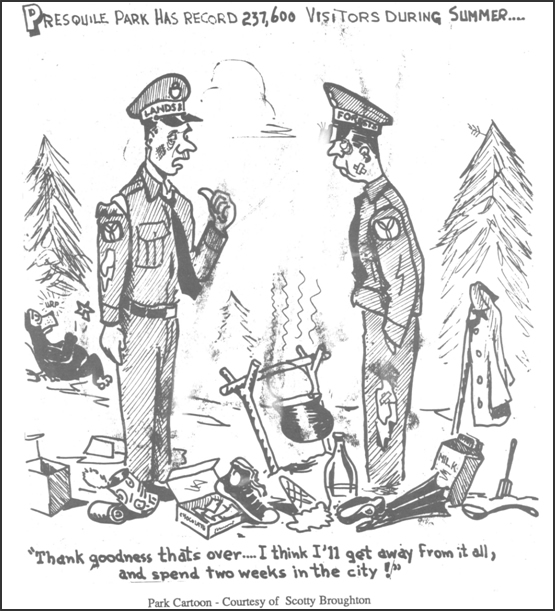
Many of the buildings had to removed. The policy of the day was that private property could not be in the park. After the Park took over and the cottages returned for the summer, they found their outhouses gone. They were forced to put in septic systems. The Park also put an end to horse riding on the trails. The lighthouse keeper’s house next to the Big Light was sold to Mr. MacDonald, a gold prospector. He added a piece to the back and stayed one year and the family did not enjoy the long winter in isolation. The following year, the Park bought that house.
After all the cottages on government leased land and the old golf clubhouse were removed, 18,260 trees were planted, and new shelters and toilets were installed. The total area taken over was 2,000 acres. This area included equal portions of marsh, woodlands, meadows, fields, beach, and sand dunes. Five hundred campsites were put in and an overflow area accommodated an extra three hundred units. There was organized camping for groups such as the Boy Scouts up to a maximum of 300. There were approximately 900 picnic tables and conveniences for visitors. A store was put in where the golf club used to be, with several small concession stands installed along the beach. They were to serve refreshments and food during the summer.
Next to the store was added a covered picnic area with cooking pits. This area had been used for family reunions or just gatherings of friends.
Presqu’ile is still a good place to explore and enjoy. At Presqu’ile you can swim or fish, you can find solitude while paddling a canoe or walking in the woods or you can relax and enjoy a leisurely afternoon picnic. There were forests, marsh, and dunes, abandoned farms and cobble beaches, and this great diversity of natural habitat supports rich plant life. Over 500 plant species have been identified by the Park staff. A wide variety of animals inhabit the Park as well. Red squirrels, eastern cottontails, woodchucks, chipmunks are common. Red foxes, hares, raccoons, skunks, deer and other animals may be observed.
Presqu’ile is also a great place for birdwatchers. Since 1957, when the official station records were first kept, 299 species of birds have been observed. Breeding evidence has been found for 104 species and 25 others were suspected to breed here. Presqu’ile is especially well known for its large gull and nesting colonies established on the islands. These islands have been designated as a wilderness area under the 1961 Wilderness Area Act.
References:
Presqu'ile Book
Limited First Edition
Published in July 1994
Written by
Susan Bergeron and Bonnie Browne
